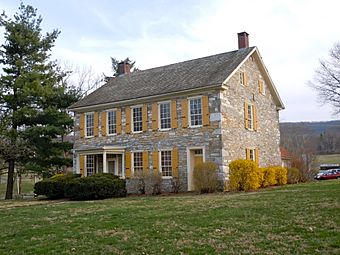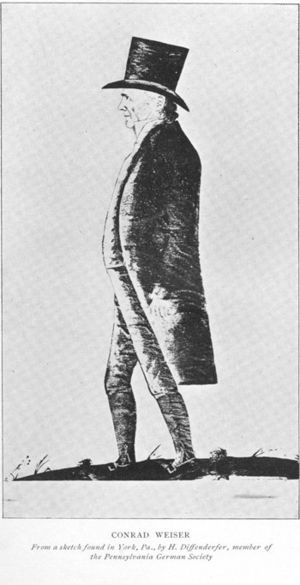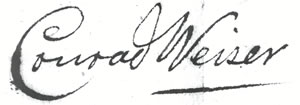Conrad Weiser Homestead facts for kids
|
Conrad Weiser House
|
|
 |
|
| Nearest city | Womelsdorf, Pennsylvania |
|---|---|
| Area | 26 acres (11 ha) |
| Built | 1729 |
| Visitation | 14,017 (2007–2008) |
| NRHP reference No. | 66000646 |
Quick facts for kids Significant dates |
|
| Added to NRHP | October 15, 1966 |
| Designated NHL | October 9, 1960 |
The Conrad Weiser Homestead is a special place in Womelsdorf, Berks County, Pennsylvania. It was the home of a very important person named Conrad Weiser. He lived here a long time ago, during the time of the American colonies.
Conrad Weiser helped the British government work with Native American tribes, especially the Iroquois. He played a big part in keeping peace on the frontier. Today, his home is a historic house museum. It is managed by the Pennsylvania Historical and Museum Commission. The site opened in 1923. It helps us remember what colonial homes were like. It also honors Conrad Weiser's important work.
The homestead has old buildings and a visitor center. It is set in a beautiful 26-acre (110,000 m2) park. This park was designed by Frederick Law Olmsted Jr.. You can find walking paths, open fields, and a pond there. There are statues of Conrad Weiser and Shikellamy. Shikellamy was an Onondaga chief. He was a good friend to Weiser. They worked together to keep peace in colonial Pennsylvania. A group called the Friends of the Conrad Weiser Homestead helps run programs at the site.
The main house was built in 1729. It was made from local limestone. Over the years, more rooms were added. But it still has an original room with a fireplace and a bake oven. Another room was added by Weiser in 1750. The house is filled with furniture and tools from the colonial era. Behind the house is a family cemetery. Conrad Weiser, his wife Anna, and several friendly Native American chiefs are buried there.
Contents
Conrad Weiser's Life Story
Early Life and Learning
Conrad Weiser was born in 1696. This was in a small village in Germany. His father was also named John Conrad Weiser. In 1709, Conrad's mother passed away. This happened after a tough time of war, sickness, and a very cold winter.
In 1710, his family moved to Schoharie, New York. Queen Anne of Great Britain paid for their trip. The German immigrants became indentured servants. This meant they had to work for a period of time to pay back their travel costs.
When Conrad was 16, his father agreed to a special request. A chief asked if Conrad could live with the Mohawks. This was in the upper Schoharie Valley. Conrad lived with them during the winter of 1712–1713. It was a hard time with cold and hunger. But he learned a lot. He learned the Mohawk language and the ways of the Iroquois. Conrad Weiser returned to his family in July 1713.
On November 22, 1720, Conrad married Anna Eve Feck. She was a young German girl. In 1723, they moved their family south. They settled on a farm in Tulpehocken. This is near where Reading, Pennsylvania is today. Conrad and Anna had fourteen children. But only seven of them lived to be adults.
Working for Pennsylvania
Conrad Weiser started working for the Pennsylvania colony in 1731. The Iroquois sent a chief named Shikellamy to talk with other tribes and the British. Shikellamy lived near Sunbury, Pennsylvania. Weiser and Shikellamy became good friends. When Shikellamy went to Philadelphia for a meeting, he brought Weiser along. The Iroquois trusted Weiser. They saw him as an adopted son of the Mohawks. Weiser impressed the Pennsylvania governor. From then on, the colony relied on him a lot. Weiser also helped as an interpreter in another meeting in 1732.
In 1736, Weiser helped with a big land agreement in Philadelphia. The Iroquois sold land south of the Blue Mountains. This land was drained by the Delaware River. This was a new way for Pennsylvania to deal with Native Americans. Before, William Penn did not take sides in tribal disputes. But this sale favored the Iroquois over the Lenape tribe. This, along with another land deal, made relations worse with the Lenape. The Lenape later sided with the French during the French and Indian War. But Weiser's work helped keep the Iroquois allied with the British.
In 1737, Weiser tried to make peace between the Iroquois and southern tribes. He traveled to the Iroquois capital. It was a six-week journey through deep snow and freezing cold. He convinced the Iroquois not to send war parties. But he could not get them to meet with the southern tribes. The Iroquois were impressed by his courage. They gave him the name "Tarachiawagon," meaning "Holder of the Heavens." This peace effort was very important. It stopped bigger conflicts that could have involved Virginia and Pennsylvania.
In 1742, Weiser was an interpreter at another Iroquois meeting in Philadelphia. The Iroquois were paid for the land sold in 1736. During this meeting, an Iroquois chief told the Lenape to move their settlements. This led many Lenape to move to the Ohio Valley. There, they could trade with the French. They also launched raids during the French and Indian Wars.
In 1744, Weiser was the interpreter for the Treaty of Lancaster. This was between the Iroquois and the colonies of Pennsylvania, Maryland, and Virginia. On the last day, an Iroquois chief spoke about unity. He said, "Our wise forefathers established Union and Amity between the Five Nations. This has made us formidable." He encouraged the colonies to do the same. Benjamin Franklin printed this speech. It later influenced ideas about political unity in America.
After this treaty, Virginia and Pennsylvania thought they had bought rights to the Ohio Valley. But the Iroquois did not believe they had sold those rights.
In 1748, Pennsylvania sent Conrad Weiser to Logstown. This was a trade village on the Ohio River. He met with chiefs from 10 tribes, including Lenape, Shawnee, and Iroquois. He helped create a friendship treaty between Pennsylvania and these tribes. The French were worried by this. They started building forts. This led to Fort Duquesne being built in 1754. This fort is where Pittsburgh is today.
In 1750, Weiser traveled to Onondaga again. He found that the Iroquois tribes' feelings had changed. The pro-British chief had passed away. Some Iroquois tribes were leaning towards the French. But the Mohawks still supported the British.
In 1754, just before the French and Indian War, Weiser went to Albany. London wanted this meeting. They hoped to get Iroquois support against the French. Representatives from the Iroquois and seven colonies were there. The meeting did not result in a full treaty. Instead, each colony made its own deals with Iroquois leaders. Weiser was successful. He negotiated a deal where some chiefs gave Pennsylvania most of its remaining land. This included land also claimed by Virginia.
In 1756, Weiser and Ben Franklin were chosen for a task. They were to build a series of forts. These forts would be between the Delaware and Susquehanna Rivers.
In 1758, Weiser attended a meeting in Easton. Leaders from Pennsylvania, the Iroquois, and other tribes were there. Weiser helped calm the tense meeting. With the Treaty of Easton, tribes in the Ohio Valley agreed to leave the French side. This loss of Native American support helped the French decide to destroy Fort Duquesne. They then left the Ohio area.
Throughout his career, Weiser's knowledge was key. He knew Native American languages and cultures. This made him vital in treaty talks and land deals. He also helped shape Pennsylvania's policies. His early time with the Iroquois made him understand their views. This might have made relations with the Lenape and Shawnee harder. But for many years, he kept the powerful Iroquois allied with the British. This helped the British colonies survive. It also helped the British win the French and Indian Wars.
Other Important Roles
Between 1734 and 1741, Weiser followed a preacher named Conrad Beissel. Beissel was a Seventh Day Baptist. For six years, Weiser lived at a religious settlement called Ephrata Cloister. His wife lived there for only a few months. But Weiser visited her often. He also took time off for his diplomatic duties. Weiser left the cloister in 1741. He returned to the Lutheran faith.
Weiser also had other jobs. He was a farmer, landowner, and merchant. He helped plan the city of Reading in 1748. He was key in creating Berks County in 1752. He served as its Justice of the Peace until 1760. Conrad was also a teacher and a church leader. He founded Trinity Church in Reading.
In 1756, during the French and Indian War, Native American raids began. Pennsylvania formed a militia. Conrad was made a Lt. Colonel. He worked with Benjamin Franklin. They planned and built a series of forts. These forts were between the Delaware and Susquehanna Rivers. In 1758, the French left Fort Duquesne. This reduced the threat.
The Homestead Today
In 2008, the Pennsylvania Historical and Museum Commission (PHMC) thought about closing the homestead. This was due to budget problems. There were also not many paying visitors. Funding was cut in 2009. Some buildings were closed.
Since 2012, the buildings open on the first Sunday of each month. This is thanks to an agreement between the PHMC and the site's Friends group. The park areas are open every day from morning until evening.
More to Explore





